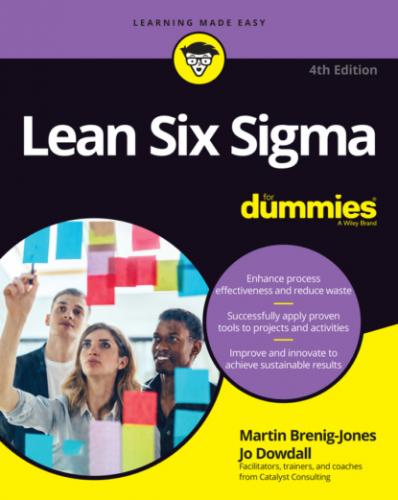8 Chapter 8FIGURE 8-1: A typical data set that doesn’t reveal very much. FIGURE 8-2: Presenting data as a run chart. FIGURE 8-3: Control chart for a process exhibiting natural variation. FIGURE 8-4: Occurrence of a special cause outside a control limit. FIGURE 8-5: New control limits set after a process review and improvement actio...FIGURE 8-6: Determining the moving range. FIGURE 8-7: Looking at the formula for the X moving R chart. FIGURE 8-8: The four states of a process. FIGURE 8-9: Taking your driving theory test. FIGURE 8-10: The driving needs improvement. FIGURE 8-11: The capability formula. FIGURE 8-12: Location, location, location. FIGURE 8-13: An example histogram. FIGURE 8-14: Looking at a long tail. FIGURE 8-15: Twin peaks. FIGURE 8-16: Looking at the vital few with Pareto.
9 Chapter 9FIGURE 9-1: The fishbone diagram. FIGURE 9-2: Creating an affinity diagram. FIGURE 9-3: The fishbone diagram meets the interrelationship diagram. FIGURE 9-4: Identifying the key drivers. FIGURE 9-5: Demonstrating correlation with a scatter plot. FIGURE 9-6: Working out the line of best fit. FIGURE 9-7: Looking out for thresholds. FIGURE 9-8: Bringing home the baby.FIGURE 9-9: Sometimes the difference is clear. FIGURE 9-10: Being logical.
10 Chapter 10FIGURE 10-1: Mapping the rework loops.
11 Chapter 11FIGURE 11-1: Working on the chain gang. FIGURE 11-2: Brian the Bottleneck. FIGURE 11-3: Banging the drum for drum, buffer, rope. FIGURE 11-4: The benefit of cells. FIGURE 11-5: Keeping it in the family. FIGURE 11-6: Calculating takt time. FIGURE 11-7: Visualizing cycle time versus takt time. FIGURE 11-8: Balancing the flow.
12 Chapter 12FIGURE 12-1: A template for brainwriting. FIGURE 12-2: Multivoting in action. FIGURE 12-3: A criteria selection matrix.
13 Chapter 13FIGURE 13-1: Weighing up the risk with FMEA. FIGURE 13-2: Square pegs and round holes: Contact error proofing. FIGURE 13-3: A shadow board helps you see at a glance if any tools are missing....FIGURE 13-4: Keeping a process performance review meeting tightly focused. FIGURE 13-5: An activity board approach to team management.
14 Chapter 14FIGURE 14-1: The DMADV phases. FIGURE 14-2: A sample design scorecard. FIGURE 14-3: Choosing between DMAIC and DMADV. FIGURE 14-4: The House of Quality. FIGURE 14-5: Seven rooms with a view. FIGURE 14-6: Competition comparison. FIGURE 14-7: The relationship matrix. FIGURE 14-8: Grading performance. FIGURE 14-9: Assessing the impact of measures on customer CTQs. FIGURE 14-10: Developing more Houses of Quality. FIGURE 14-11: The Pugh Matrix.
15 Chapter 15FIGURE 15-1: The double diamonds of Design Thinking. FIGURE 15-2: The persona map. FIGURE 15-3: An empathy map. FIGURE 15-4: The “how might we?” template. FIGURE 15-5: The experiment grid.
16 Chapter 16FIGURE 16-1: The scrum. FIGURE 16-2: The T-shaped person. FIGURE 16-3: The user story card. FIGURE 16-4: A simple Agile kanban board.
17 Chapter 17FIGURE 17-1: A typical outline Rapid Improvement Event Plan. FIGURE 17-2: An example A3.
18 Chapter 18FIGURE 18-1: The Process Management Chart includes essential process informatio...FIGURE 18-2: A template to support Leader Standard Work. FIGURE 18-3: The cultural web is essentially “the way we do things around here....
19 Chapter 19FIGURE 19-1: Successful deployment. FIGURE 19-2: Applying Lean Six Sigma to processes. FIGURE 19-3: So many options to choose from! FIGURE 19-4: Three steps to project selection. FIGURE 19-5: Identifying where suggestions come from. FIGURE 19-6: A list of criteria for assessing project viability. FIGURE 19-7: Benefit-effort matrix for screening projects. FIGURE 19-8: Being business wise with the business Ys.
Guide
1 Cover
4 Table of Contents
6 Index
Pages
1 i
2 ii
3 1
4 2
5 3
6 5
7 6
8 7
9 8
10 9
11 10
12 11
13 12
14 13
15 14
16 15
17 16
18 17
19 18
20 19
21 20
22 21
23 22
24 23
25 24
26 25
27 27
28 28
29
